Since its inception in the early 1980s, cyberpunk has established two distinct kinds of worlds. There’s the post-industrial dystopian cityscape, like modern Japan on crack but shaded with enough darkness to be appropriately noir-y; and there’s cyberspace, the virtual world running parallel (or sometimes perpendicular) to the real one. With corrupt corporations calling the shots, it makes sense that the punks would retreat into the digital space, an idealized version of their downtrodden daily lives malleable enough that they can create their own private universe. When you can look whatever way you want and challenge the laws of physics, why would you want to return to the real world?
When a cyberpunk novel was published says a lot about the virtual reality it depicts; while VRs share certain key elements, what they mean to their characters and their particular world is very dependent on the larger context. Looking at 10 books spanning 33 years, let’s examine the evolution of VR in cyberpunk: there’s a lot of change between Vernor Vinge and John Scalzi, as VR morphs from liminal space to its own plane of existence—entertaining, torturing, and elevating its users along the way.
The Other Plane, “True Names” (1981)
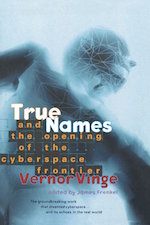 Nyms > Names
Nyms > Names
While many view William Gibson’s Neuromancer as the progenitor of cyberpunk, Vernor Vinge’s novella brought up many of the same notions (albeit under different names) a few years earlier. The Other Plane is a virtual reality along the lines of the MMORPGs (massively multiplayer online role-playing games) that began appearing online in the mid-1970s: an open-ended game or meeting space for users, in this case mostly hackers. Anyone who came of age in the early days of the Internet will recognize the intense paranoia and secrecy surrounding the Other Plane users’ screen names, or nyms (short for pseudonyms). If another user discovers any of your identifying information, you’re “in thrall” to them; either they’ll sell you out to the law, or blackmail and hack you. It’s no surprise that users refer to themselves as wizards or sorcerers; as in fairy tales and other fantasies, knowing your opponent’s name gives you untold power.
Unlike many of the other virtual spaces in cyberpunk, which physically bind their users in some way, The Other Plane doesn’t require a neural plug-in—just the ability to subtly detect the borders of the digital space. Using an EEG (electroencephalogram), you train your brain to “see” The Other Plane and learn how to manipulate it.
Cyberspace/The Matrix, Neuromancer (1984)
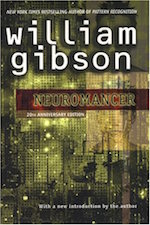 The Virtual Becomes Personal
The Virtual Becomes Personal
As one of the first depictions of virtual reality in cyberpunk, Neuromancer spends almost as much time on what it’s like to be cut off from the matrix: At the start of the novel, former “console cowboy” Case, as punishment for stealing from his shady employers, has his central nervous system poisoned with a mycotoxin. Cyberspace—the novel coined the term and basically acted as a blueprint for the World Wide Web—was a second home and a source of income, and now both are closed off to him. Until, that is, a new employer offers to cure him, in exchange for those legendary hacker skills.
As he descends into layers of conspiracies and shadowy aims, however, Case discovers new corners of cyberspace, especially when he’s being guided by insidious AIs. What begins as building blocks of abstract data gives way to a digital space constructed in minute detail from Case’s sensations and memories—including a reconstruction of his dead girlfriend, intended to trap him. The AI Neuromancer’s reality, which he later visits, is a blend of the two: not specifically tailored to Case, but nonetheless nearly as real-looking/-smelling/-feeling as real-life. It’s clear that in cyberpunk, the limitless opportunities of virtual spaces are enough to hook their users; but personalizing these spaces by mimicking the real world is where the real manipulation begins.
The System, Synners (1991)
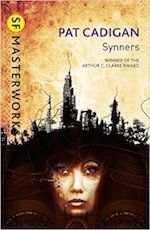 VR as Entertainment
VR as Entertainment
As if they were living in a virtual company town, the three protagonists of Pat Cadigan’s Synners all make a living off designing VR entertainment for the masses: immersive movies and music videos experienced through “sockets” that feed information directly to consumers’ brains. As “synners” (short for “synthesizers”), Gina, Visual Mark, and Gabe are both creator and—in Mark’s case, at least—test subject, specifically for a new implant that purports to create prerecorded dreams. Gabe’s ambivalent relationship to sockets mirrors Case’s, as he inhabits a virtual world of his own creation, with customized virtual companions. However, once he has the sockets implanted, he finds that he doesn’t “fit” as well into these virtual worlds.
For Mark, it’s the opposite: Already distanced from his physical form through frequent drug use, he finds total escape in the System, plugging himself in directly and abandoning his body to the point of decay and eventual clinical death. Even before that final tie is cut, Mark’s consciousness has already spread to various pieces of technology. Yet despite his great reach, Mark is still just as alone in virtual space as he was in physical space. A recurring motif in Synners is the phrase “change for the machines,” which is introduced innocuously enough (Mark looking for coins for the vending machine) but becomes Mark’s mantra, as he tells a coworker:
“That’s a good way to put it. How did you know? […] My whole life has been, ‘Okay, change for the machines.’ Every time they bring in a new machine, more change.”
Metaverse, Snow Crash (1992)
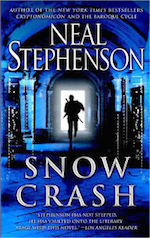 Monetizing VR
Monetizing VR
As the “convergence of virtually enhanced physical reality and physically persistent virtual space,” the Metaverse collects virtual worlds, augmented reality, and the Internet… not unlike the real world’s Second Life, which was created in 2003. In fact, Second Life provides an apt parallel, as the Metaverse marks a shift in the increasing monetization of virtual realities. When hacker Hiro Protagonist first helped to code the original Metaverse, everything was free; it was a playground for hackers to experiment. But by the start of the book, the Metaverse has become just as class-stratified and capitalist as real life, thanks to billionaire L. Bob Rife’s monopoly of the worldwide fiber optic cable network: The moment you drop in, you’re bombarded with ads; other users can immediately ascertain (and judge) your social status depending whether you logged in from a public or private terminal. There’s a hierarchy in the Metaverse, in which how much money you spend communicates your elevated status by customizing your avatar to look more hi-res than the average one and by gaining access to the exclusive Black Sun club.
While dying in the Metaverse simply means getting logged off IRL, Hiro and skateboard courier Y.T. discover something much more sinister: Snow Crash, a computer (and central nervous system) virus that both infects hackers’ computers and scrambles their brains. Transmitted through an avatar carrying a scroll filled with code, it’s a targeted way to take out the Metaverse’s original architects.
The Net, Otherland (1996-2001)
 You Die in the Net, You Die in Real Life
You Die in the Net, You Die in Real Life
Tad Williams’ series envisions a similar Metaverse to Neal Stephenson’s, populated by multiple VR spaces (accessed by implanting Neurocannulas into the back of one’s neck) and overseen by the corporate entities that have outpaced the government in terms of power and control. But while we’re again looking at ownership of VR, it’s not money that these corporations are doling out—it’s lives. Virtual engineering instructor Renie Sulaweyo becomes personally entangled with the darker corners of the Net when she investigates the mysterious Tandagore Syndrome, which sends many of the Net’s young users, including her younger brother, into inexplicable comas. As she investigates deeper, crossing paths with two prolific Net gamers, they stumble upon a conspiracy involving the Grail Brotherhood that gets them cut off from their physical bodies. Trapped in the Net, they can’t log off; if they get killed in VR, they won’t wake up IRL.
The Grail Brotherhood’s agenda taps into fears of the singularity, with one artificial intelligence superseding even the corporations and controlling all of the Net’s citizens. The Otherland series can also serve as a cautionary tale about how immortality isn’t all it’s cracked up to be; unlike Synners’ Mark, who chooses to transcend his physical form, the protagonists searching for the eponymous golden city have no choice but to travel through the digital realm for ages.
Download Centers, Altered Carbon (2002)
 Virtual Torture
Virtual Torture
While antihero Takeshi Kovacs pushes the noir part of cyberpunk into full-on hardboiled detective territory, and the first book of the series establishes a future where humans have achieved space travel, it’s still cyberpunk because of the proliferation of virtual spaces. Humans can basically attain immortality by downloading their personalities and consciousnesses into new “sleeves,” or bodies. Resleeving is mostly a luxury of the rich, who can afford multiple young replacement bodies, but anyone can extend their lifetime, even in a body that ages normally.
Virtual reality is also a key component of space travel, as humans cannot survive faster-than-light voyages on their own. Instead, their consciousnesses are transferred to download centers, where they are resleeved into new physical bodies—as happens to Takeshi when he must be resleeved into a detective’s body to solve a suicide that may actually have been a murder. However, poking into this mystery drops Takeshi into a more terrifying virtual space: a computer world in which victims are tortured for what feels like hours but is only a matter of minutes in real-time. While Richard Morgan’s VR doesn’t quite resemble the others on this list—maybe the Net in Otherland—it depicts a future in which VR is both boringly commonplace and singularly horrifying.
Alien Router/Singularity, Accelerando (2005)
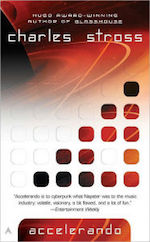 Double Life
Double Life
This review from nerds of a feather, flock together best sums up Charles Stross’ cyberpunk visions (told through linked novellas) of the future: “This is the augmented reality future to Neuromancer’s virtual reality future.” No one exemplifies this better than Manfred Macx, who stores information and his memories inside an external wearable computer (not unlike a Google Glass) and constantly lives with one foot in the virtual world and one in the physical one. But Macx’s existence is just one step in humankind’s evolution; a generation later, his daughter Amber is one of many who upload their entire consciousnesses into an alien router (which brings to mind today’s cloud).
To say that the Macx family and their contemporaries lead double lives is twofold: Yes, there is the ability to effectively exist in two places at once between digital space and meatspace. But those characters whose physical forms die receive not only a double life but a second chance—the ability to live on in the router network, like Amber and her family, who scrabble for control against the posthuman intelligence residing in the inner system.
OASIS, Ready Player One (2011)
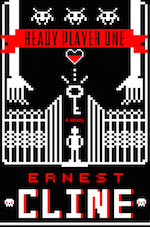 Easter Egg Hunt
Easter Egg Hunt
By the time Ernest Cline wrote his 1980s-throwback dystopian cyberpunk novel in 2011, virtual worlds were something we were used to getting lost in. Ready Player One is the rare cyberpunk novel that hammers home just how shitty the real world is; its near-future 2044, so overcrowded that people have built skyscraper-tall “stacks” of mobile homes and shacks, feels uncomfortably possible. Wade Watts escaping his grim reality for the virtual universe of the OASIS doesn’t make him special; it’s a worldwide coping mechanism.
Jacking in to the OASIS may evoke similar lingo to Neuromancer, but it trades out the slotting of chips for laptops, goggles, and haptic gloves reminiscent of Snow Crash‘s much-maligned “gargoyles” (Metaverse users wearing portable terminals). Regardless, its users may as well be physically connected to futuristic Willy Wonka James Halliday’s virtual (and free!) Chocolate Factory, seeing as they basically spend their entire lives—often in avatars that are idealized versions of themselves—living, working, and traveling in the virtual space. Wade even attends school in the OASIS, where he can go on field trips to the countless planets recreating everything from Middle-earth to Firefly‘s ’verse.
The other defining factor of Halliday’s playground are the Easter eggs he left in there—clues to his billion-dollar fortune, to be gifted to the cleverest and most resourceful person to solve his puzzles. Halliday’s final challenge has created a society of gunters (egg hunters) who devote all of their time, energy, and money to researching ’80s references, the era of Halliday’s coming-of-age. The Verge has published an excellent piece on how terrifying the OASIS actually is, because it traps its users in a constant loop of experiencing the same nostalgia without commenting or critiquing on it, much less creating anything new.
The Archive, Tomorrow and Tomorrow (2014)
 Social Media for the Dead
Social Media for the Dead
Ten years after a nuclear bomb wiped Pittsburgh, PA, off the map—and ushered in a draconian, surveillance-choked United States—survivor John Dominic Blaxton spends all of his waking hours in the Archive, a virtual recreation of Pittsburgh. Ostensibly he works for a digital insurance company investigating any coincidental deaths that occurred before the bomb was dropped, but the real reason he took the job was to relive his final moments with his wife (pregnant with his child), who perished in the nuclear blast. The fully-interactive Archive is open to survivors and tourists alike, a warped amplification of our present society’s morbid tendency to keep operating Facebook profiles of the deceased as if they’re still just one click away.
Blaxton is content to stay in the Archive rehashing the same details of a hollow not-quite-life, until a client asks him to look into a baffling glitch: Every detail of his deceased daughter’s existence is being wiped from the Archive. Like in any good cyberpunk novel, Blaxton’s investigation crosses between the digital and real worlds, with online mysteries translating into offline conspiracies. But more than the typical against-the-world mentality of cyberpunk, Blaxton’s dilemma parallels ours: It’s one thing to know that a digital space exists, but how much can you control yourself to stay out of it and let go of the past?
The Agora, Lock In (2014)
 VR as Safe Space
VR as Safe Space
Explaining how the Agora works to someone who is not a Haden is like explaining the color green to someone who is colorblind. They get a sense of it, but have no way to appreciate the richness and complexity of it because their brains literally don’t work that way. There’s no way to describe our great meeting places, our debates and games, or how we are intimate with each other, sexually or otherwise, that doesn’t sound strange or even off-putting. It’s the ultimate in “you have to be there.”
After Haden’s Syndrome spreads and 1% of those infected become “locked in” (trapped in their bodies and unable to move), the Agora is created as a nonphysical—not virtual—meeting and living space for Hadens, accessed through a neural link. Like its ancient Greek predecessor, the Agora is open, both literally (there are few dividers unless you code houses, caves, or other private spaces) and figuratively (characterized by extreme openness and free sharing of personal information without fear of it being used against them). While the other cyberpunk virtual realities on this list may feature typical citizens, the Agora is created for a very specific subset of the population; Dodgers (those unaffected by Haden’s Syndrome) regard it with anything from skepticism to fear.
When Hadens have no choice but to interact with Dodgers, they must use another neural link to upload their consciousnesses into “threeps,” or robots that allow them to navigate the physical world with all five senses. But there’s a growing movement of Haden separatists, led by a Haden who grew up in the Agora starting in utero, who advocate for keeping Hadens in the Agora and forcing Dodgers to interact with them on their terms, rather than the other way around. Not surprisingly, they’re met with opposition from Dodgers who don’t want the status quo to change, who couch their unease in studies designed to eradicate Haden’s Syndrome. When access to the nonphysical space is embedded in a group’s identity, it’s understandable that they rankle at the idea of a “cure” that will destroy an entire culture.
Today, we’re closer than ever to VR as part of our daily lives. More and more companies are developing their own take on VR headsets, with the Oculus Rift (Facebook), Project Morpheus (Sony), and HTC Vive setups coming to living rooms; the Asus VR and Samsung Gear VR are some of the increasing number of smartphone accessories. In 2015, British startup Improbable launched the SpatialOS, which the company believes could be the missing puzzle piece to create a real-life OASIS, a simulated universe where you can’t see the borders between the virtual and physical worlds. While the baseline technology exists, it’s changing so fast—think of early-generation smartphones—that today’s innovations will seem outdated in just a few years. Further, these companies are still working to bring the content up to the level of the technology, for that seamless experience.
Whether real-life VR will follow the evolution of cyberpunk’s VR is yet to be seen, but it certainly seems likely. What begins as a personalized escape, a digital landscape studded with the memories and touchpoints we choose, grows increasingly commercial as the aforementioned corporations—not to mention looming artificial intelligences—catch up and take the control out of our hands. Instead of freely offering up those memories, we see them extracted and used against us, for a pretty penny. But a key element of VR is that it’s constantly changing—so there’s still hope that even as external forces seek to market VR as a product, humans take it back and turn it into a subculture.
Natalie Zutter never joined Second Life, but is not tempted to. Tweet at her about virtual reality!











I always thought that Delany’s Nova was one of the first virtual reality stories, with its “sockets”. Maybe more cyborg or reality enhancement, though.
Pointless nitpick: Gibson coined the term in the short story “Burning Chrome,” which predates Neuromancer.
Fascinating to see a trajectory for VR, now that emergent technologies are breaking through. Curious about the difference between AR and VR, and which is the more “immersive” experience, as technologies develop.
It’s not a “pointless nitpick”; Gibson coined the term “cyberspace” and introduced it in his “Sprawl” stories, which include “Burning Chrome”, other short fiction and the “Cyberspace”/”Sprawl” trilogy (“Neuromancer”, “Count Zero”, “Mona Lisa Overdrive”). As for Vernor Vinge, his work anticipates cyberpunk, but I wouldn’t quite list him or his treatment of virtual reality as being indicative as to where cyberpunk would head, not least because a better progenitor might be Samuel Delany’s “Nova”, not only for the technology, but it creating a near future urban landscape that would be recognizable to the characters inhabiting Gibson’s “Sprawl” near future.
I wanted to love Ready Player One. I wanted to love it so much, it promised everything, the concept is amazing…but by god…I could NOT stand the 80’s references! Here or there they would be great but they were like speedbumps. You’d get like 5 pages of great plot only to be smacked in the face by a 4 page description of Back to the Future or War Games or LadyHawk. It got SO cringy and annoying I couldn’t get passed it. It’s basically the novel form of the Big Bang Theory format, “Here let me mention a nerd thing look at me I’m relevant and funny!” I don’t understand the nostalgia, especially since I grew up on 80’s culture as well. It would’ve been fantastic if Ernie just laid off the references.
“Ready Player One” is rather dull, quite lifeless, and lacks the literary eloquence to be found in the best cyberpunk/post-cyberpunk fiction from the likes of William Gibson, Bruce Sterling, John Shirley, Michael Swanwick, James Patrick Kelly, Marc Laidlaw, Norman Spinrad (“Little Heroes”), Matt Ruff (“Sewer, Gas and Electric: The Public Works Trilogy”, “The Mirage”), Pat Cadigan, Kathleen Ann Goonan, Chris Moriarty, George Alec Effinger, Walter Jon Williams and Greg Bear. Oddly enough, it came out almost at the same time as Neal Stephenson’s ‘Reamde” and though “Reamde” isn’t my favorite novel of his – it’s probably “The Diamond Age” and “Anathem” – “Reamde” has far more interesting characters, tighter plotting and a far more interesting computer game.